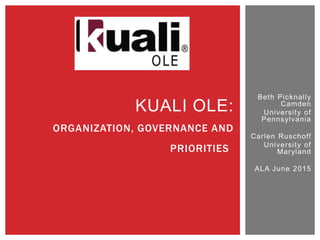Kuali OLE: Organization, Governance and Priorities
- 1. Beth Picknally Camden University of Pennsylvania Carlen Ruschoff University of Maryland ALA June 2015 KUALI OLE: ORGANIZATION, GOVERNANCE AND PRIORITIES
- 2.  A community within a community—Part of the Kuali Foundation  Designed for libraries by librarians!  KOLE is building to meet the following requirements:  Flexibility in design  Community ownership with an open source license  Modular Service-Oriented Architecture  Enterprise-level integration What Is Kuali OLE?
- 3. OLE Partners
- 4. University of Chicago – Summer 2014 Lehigh University– Summer 2014 SOAS (University of London) – Spring 2015 Planning for implementation: Duke (Winter 2015/16); Penn, Villanova (summer 2016) OLE Implementations
- 5. 1.6 (May 2015) FY rollover; Internationalization; SIP2 2.0 (Q3 2015) ERM; GOKb integration 3.0 (Q1 2016) Circ upgrades (bills, requests); authorities; MARC holdings; license editor; account query https://www.kuali.org/ole/roadmap OLE Roadmap
- 6. ï‚¡Stage 1: Build & Early Adoption ï‚¡Stage 2: Growth & Innovation ï‚¡Stage 3: Next round of Implementations and refining the code OLE Development Stages
- 7. ï‚¡Kuali Foundation 10 year Review ï‚¡Taking Stock & reviewing options Stage 2: Strategic Planning
- 8. ï‚¡Visioning over the summer ï‚¡Priorities for development of 4.0 ï‚¡Extend the partnership Stage 2: Next Steps
- 9. ï‚¡Next round of implementations ï‚¡Refining the code ï‚¡Building on the infrastructure Stage 3: 2016-2018
- 10. ï‚¡What are the features that you would like to see in a next gen system? ï‚¡In which direction should systems be moving? ï‚¡What would be most useful for your future workflows? Discussion: "Next Generation" Library Systems
Editor's Notes
- #3: quick overview – what is OLE? OLE = Open Library Environment Designed for libraries by librarians! Designed by and for academic and research libraries for managing and delivering intellectual information. KOLE is building to meet the following requirements: Flexibility in design Community ownership with an open source license and strong vendor support Modular Service-Oriented Architecture Enterprise-level integration Software Enterprise Java with services middleware; Built to integrate & interoperate; A platform for library services










